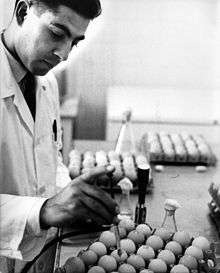Razi Vaccine and Serum Research Institute
 | |
| Public Sector | |
| Founded | Karaj (1924) |
| Founder | Mustafa Qoli Bayat |
| Headquarters | Karaj, IRAN |
Production output | Human and Animal Medicines |
Number of employees | circa 2000 |
| Website |
www |
The Razi Vaccine and Serum Research Institute is an Iranian pharmaceutical company. It is located in the Hessarak district in Karaj, Iran. The Institute was built as a national center with the purpose of countering epidemics in domestic animals during Reza Shah era. Further departments were installed, including those dedicated to human medicines. In modern years, the Institute has focused primarily on nanomedicine and biotechnology.[1][2]
The Institute is known for its anti-venom serums derived from snake and scorpion venom. It hosts some reference pharmaceutical laboratories with regional or state scopes.[1][2]
The Institute has struggled to implement Good manufacturing practice (GMP) as mandated by World Health Organization (WHO) requirements.
Branches
The Institute has established regional branches in:
History

Production timeline
- 1924: Institution of the institute.
- 1932: Louis Delpy, a French veterinarian, drove the institute to overcome an epidemic of cattle plague in the region.
- 1933: Anthrax
- 1935: Sheep Pox
- 1936: Livestock Gangrene
- 1937: Cattle Pasteurellosis
- 1941: Serums and vaccines for diphtheria and tetanus
- 1970: Polio
- 1987: Rubella and Measles
- 1998: Aleppo Boil
- 1992: Foundation of the biotechnology department.
- 1997: Enhancement of the biotechnology department.
- 2010: The institute produced 1.7 billion doses of 57 types of vaccines, serums, and antigens per year.
- 2012: Production of transgenic animals, creating recombinant vaccines through genetic engineering, developing antigens and diagnostic kits for medical and veterinary labs.
Current research projects
- Creation of stem cell lines from mice fetuses through cloning
- Design and production of engineered skin tissue
- Molecular analysis of the CDS gene in cattle to diagnose genetic defects
- Production of hybrid cells
- Production of recombinant vaccines
- Production of a monoclonal antibody for measles
History points
- The facility was used as a Soviet military base during World War II
- NATO forces used some of the Institute's anti-venom products during the Afghanistan war, since Afghan native snakes had not been researched in the USA or Europe.[3]
See also
References
- 1 2 http://www.nti.org/country-profiles/iran/biological/
- 1 2 Mahboudi, F; Hamedifar, H; Aghajani, H (2012). "Medical biotechnology trends and achievements in iran". Avicenna Journal of Medical Biotechnology. 4: 200–5. PMC 3558225. PMID 23407888.
- ↑ "Pentagon relies on Iran in fighting for soldiers' health in Afghanistan". RT. Retrieved November 2014. Check date values in:
|accessdate=(help)